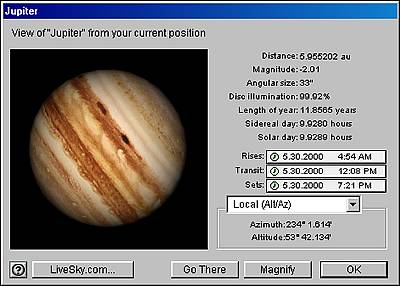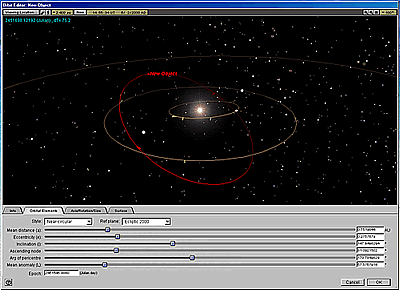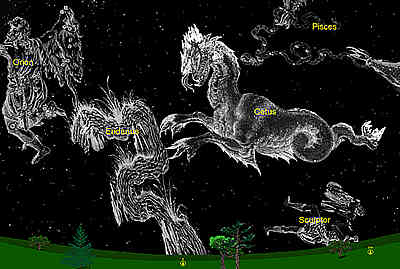Starry Night Basic versus Starry Night Backyard
![]() s
an owner of Starry Night Basic, you would probably like to know
what is new in Starry Night Backyard.
We have tried to make Starry Night Backyard the perfect "family's guide
to the night sky", both by increasing its simulation power and information
content, and making it even easier for beginners to use.
s
an owner of Starry Night Basic, you would probably like to know
what is new in Starry Night Backyard.
We have tried to make Starry Night Backyard the perfect "family's guide
to the night sky", both by increasing its simulation power and information
content, and making it even easier for beginners to use.
As a courtesy to our customers, we offer upgrades to existing owners of Starry Night Basic. You can order it online.
The new features in Starry Night Backyard can be split into three major areas:
- More data & information on celestial objects
- Better simulation capabilities
- Improved appearance of the sky
Please read on for a description of the new features in each of these areas.
More Data & Information on Celestial Objects
- More stars. Starry Night Basic had a database of 14,000 stars, which was sufficient to include all the stars that can be seen with the naked eye. However, a look through even the smallest pair of binoculars would reveal stars not present in Starry Night Basic. Starry Night Backyard beefs up the star database to include about 1 000 000 stars, which is sufficient to cover almost all the stars you can see through the most powerful binoculars and smaller telescopes.
- More Messier images. Starry Night Basic included full-size
images of only 15 of the Messier objects, whereas Starry Night Backyard
includes images of all 110 objects in the catalog, including favourites
like the Crab Nebula and the Orion Nebula.

Crab Nebula
- Heads-Up Display (HUD). Starry Night Backyard automatically display an object's name, constellation & distance when you hover the cursor over it. There is no need anymore to switch tools and click the mouse button to find out what you are looking at!
- Info Windows. If you want to know more about an object than
is provided by the heads-up display, just double-click on any object
in the sky to bring up an Info Window with more information on the object.
The information will vary depending on the type of object, but can include
its name, magnitude, distance, rise & set times, co-ordinates in any
co-ordinate system, and much more.

Info Window of Jupiter
- Interesting Events menu. This new feature brings up a list of interesting celestial events such as lunar & solar eclipses & planetary conjunctions, sorted by date. You can click on any event and choose "local view" to see how the event looked from your home location, or choose "best view" to see the event from the ideal viewing location.
- "What's Up Tonight?" Clicking this menu option in Starry Night Backyard will transport you to a special page on our LiveSky website which is updated daily with tips and information on objects which are currently prominent in the night sky.
- Detailed manual. Starry Night Backyard comes with a complete manual to help you learn more about its features. The CD version comes with a printed manual, while owners of the electronic version receive a manual in PDF form.
Better Simulation Capabilities
- More viewing locations. Starry Night will now allow you to view the sky from anywhere within 20,000 light years of Earth! Click on any planet, satellite, or comet and press the "Go There" button to be transported to the surface. Or leave the solar system behind and head out to Sirius (or any other nearby star) to see how the night sky & constellations look different from there.
- Orbit Editor. This powerful feature allows you to add your
own satellites, comets, moons, planets, asteroids & satellites to Starry
Night Backyard. Add recently discovered comets & new spacecraft, or
invent your own new planet! SPACE.com Starry Night's web site maintains
orbital elements for comets, asteroids & satellites to help you add
them easily to the program.

Oribit Editor
- "Go" menu. This new menu instantly transports you to cool views such as a view of the solar system from high above the sun, a look at the earth and the satellites circling it, a 3-dimensional view of the stars in the solar neighbourhood, and more.
- QuickTime movie tool. With this feature you can make movies of your adventures in Starry Night Backyard. Film a comet's journey over the months as it approaches the earth and grows brighter in the night sky, or a movie of yourself blasting off from Earth and travelling out to Jupiter.
- Export as image feature. Save colour screen images to print out or post on your website. Starry Night Backyard allows you to save screen images in a variety of popular graphics formats, such as PICT and JPEG.
Improved Appearance On The Sky
- More realistic-looking stars. Choose from several levels of light pollution to add a glare and more closely resemble your own sky. Show the stars in their red & blue tinges and use sliders to set the color levels, brightness and contrast of the stars.
- Better Constellations. Use the "AutoIdentify" feature to scroll
around the sky and automatically bring up a classical image of the constellation
at the center of your screen (for all constellations, not just those
in the Zodiac). Display common asterisms such as the Dippers and the
"W" of Cassiopeia.

Some Images of Constellations
- Field of View indicators. Add outlines of common binocular types to your screen to show you how large an object would appear when seen through these instruments. -Better star charts. Starry Night Backyard prints charts with a special set of settings to make legible, high-quality star charts without overlapping labels.
- Better star charts. Starry Night Backyard prints charts with a special set of settings to make legible, high-quality star charts without overlapping labels.